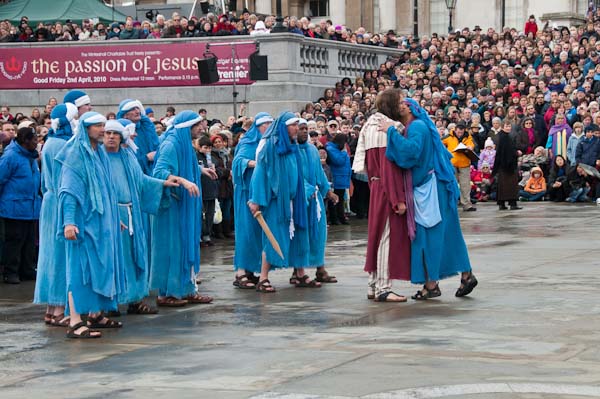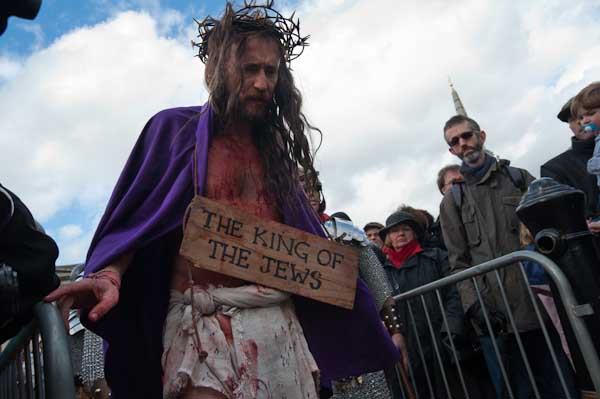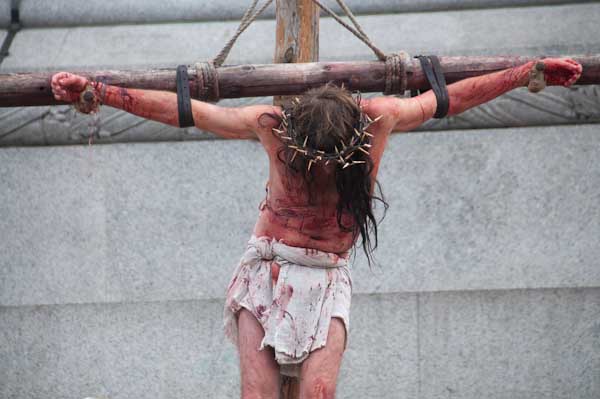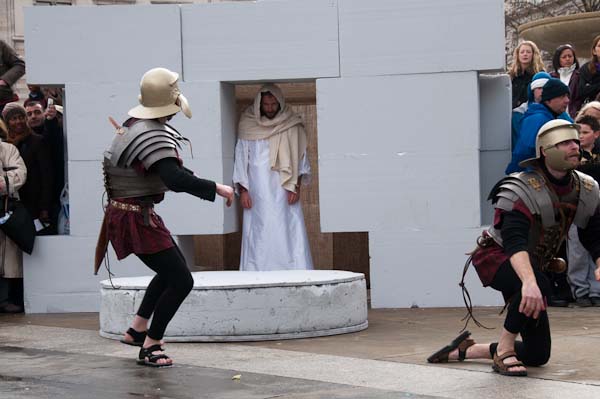This Good Friday I photographed the first Passion Play to be performed in Trafalgar Square for 45 years, and it was in many ways an interesting event.

Judas betrays Jesus with a kiss
It was also one that I’ve heard many rather silly things being said about. Some people have been heard making complaints that Christians aren’t allowed to tell their stories any more, that children don’t learn about Jesus in schools and that while Muslim or Sikh or Hindu festivals are encouraged by councils and celebrated in public places, Christians are not allowed to do the same.
It just is not true. There may be a few isolated cases where schools have decided not to celebrate Christmas in the traditional way, or where councils have banned Christmas greetings, but mostly they go on doing so. Christian groups who provide school assemblies may not get into every school, but the services they offer are still very much in demand and certainly not just in faith schools, and there are plenty of public celebrations of Christianity, with pilgrimages, Good Friday walks of witness, and various other processions. In London we have several annual Orange parades and Catholic processions, the annual blessings of the river, the Jesus Army all taking to the streets and more.
There are probably more of these events now than there were twenty years ago. It is certainly true that many lack the colour and excitement (and numbers taking part) of festivals such as Vaisakhi, Milad un Nabi, Arbaeen or Diwali celebrations but you can hardly blame the other religions for that. It’s also true that as a photographer I generally find myself made rather more welcome at the events of other religions than at some Christian events I’ve attended.
I very much welcomed ‘The Passion of Jesus‘ as an attempt to put some spectacle into public Christian events, and was pleased I was able to photograph it. I did so alongside a couple of agency photographers, and it was perhaps an event that brought out the differences between the way you have to think to be successful at that job and the way I prefer to work.
Newspapers generally want a single picture of anything. Often they don’t seem too worried about exactly what it shows, although it helps to be visually dramatic and preferably very straightforwardly linked to the subject. Rather too often the pages are actually produced by the journalists with blank spaces to be filled by whatever the designer/art editor/picture editor happens to find at the agency where they have a bulk contract so individual images come basically for free.
Photographs are generally seen as something that simply adds to the text, which is the basis of the story. Perhaps images are a necessary evil to brighten up the page and break up the text, but the approach is still almost entirely logo-centric, even in most sections of the tabloid press.
Agency photographers tend to think of events in terms of two or three very specific images. “Jesus on a donkey, a crown of thorns and Christ on the cross.” Because they know that this will be what the papers will see and want. There is also a market for some generic type of picture, such as “weather images” and at least one of the guys was praying for rain to get some good shots with lots of umbrellas in the background, though fortunately it stayed dry for the performance.

The King of the Jews – Jesus wearing the crown of thorns
Photographing for the agencies is a specialist and skilled job, and I would not want to detract in any way from the professionalism and results people doing it produce often taking pictures I would have very much liked to have made myself. But while the kind of pictures they were seeking were things that I too wanted to photograph (and I got two out of the three on their list to my satisfaction) I don’t really see any story in terms of single pictures. I want to use pictures to tell the story – and of course good pictures do help in that.

Jesus wearing the crown of thorns hanging on the cross
I’m also not up with the working methods and technology to be an agency photographer. I’d certainly have to rethink my procedures and equipment to get pictures in on time. I seldom carry a computer when out taking pictures and like to carry out quite a bit of post-processing before uploading pictures. For me its often a rush job to get pictures out by the following day, let alone the few minutes which agencies now expect. (It can be seconds in the case of important events such as the Olympics, but photographers have a backup team to help there.)
I could probably learn to do it if I had to. It would mean buying a new notebook computer that was up to the job and carrying that around in a new, slightly larger bag. And shooting combined jpeg plus RAW rather than RAW alone as I do now, editing rapidly on the spot and letting images I know I could improve on being sent for publication with little or no post-processing.
It would also mean rushing away from events to file pictures. Both my colleagues from the agencies I think left after the crucifixion scene, as they had the pictures they needed. I didn’t, because I knew that the story hadn’t ended. In fact if that had been all there would be no story to photograph.
And stories, in pictures and in words are important to me. I’m happiest to see my pictures used with my text telling the story I want to tell. For some years I was fortunate enough to get paid for almost everything I wrote, but now mostly I publish for free and scrape a small income around the edges. Fortunately I don’t need a great deal to live on, so I can get by doing what I do.
Often when I’m taking pictures and mention My London Diary to people they tell me that they know the site and look at it. My own sites do get the stories out to a reasonable -but not huge – readership around the world, the kind of readership figures that some magazines would be happy with and that could generate some useful income if I put advertising on the site, but I prefer it without. Stories on Demotix get a lot of views too, especially if as mine often do they make the front page.

Jesus emerges from the tomb, scaring the Roman soldiers on guard
The resurrection isn’t an easy story to tell either in a play or in photographs. Artists over the years have found the crucifixion a much more dramatic event to work with. But had death been the end of it, there would have been no Christian religion, nothing to remember two thousand years later, no history of millions of people over the years inspired and energised by whatever it was that happened.
It was something I thought about again this morning as I stood with around 20 or so others not too long after dawn outdoors in light rain facing the River Thames and celebrating Easter (I did take a couple of photographs, but they aren’t very interesting so I won’t post them.)
At its heart what happened after the crucifixion remains a mystery. The Gospel writers differ considerably about it, and perhaps it is impossible to represent with an actor playing the role of Jesus, whose presence is necessarily so physical. It was the part of the performance I was least impressed by, and also where I was least impressed by what I made of it in my pictures. But when I uploaded the text and pictures to go on line at Demotix, I knew this was the most important part to show. Death without resurrection is no story, whatever the papers think.
More pictures of the Passion Play are now on line at:
http://mylondondiary.co.uk/2010/04/apr.htm#jesus
This year’s Good Friday Procession is at:
http://mylondondiary.co.uk/2010/04/apr.htm#crucifixion